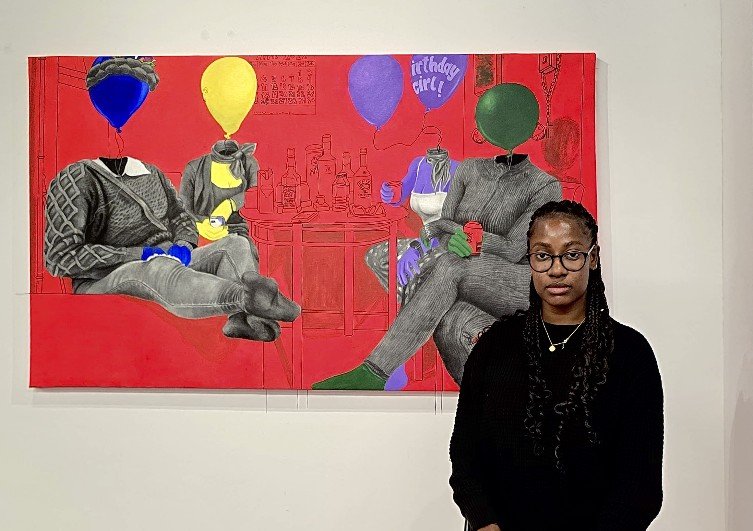NEW LONDON – It was the Y2K of the Renaissance.
For many, the year 1500 loomed like a divine crescendo, said Tanya Pohrt, curator of the Lyman Allyn Art Museum in New London, which recently opened “Albrecht Dürer: Master Prints.”
Priests, ministers and prophets were consumed with the belief that an angry God would soon exact the final punishment for the depravity and degeneracy they insisted was polluting Europe. Into that molten fear strode the Northern European painter, printmaker and theorist, Albrecht Dürer, who, in 1498, showed Europe just what such an apocalypse would look like.
In his “The Four Horsemen, from ‘The Apocalypse,’ “ now on view at the New London museum, four horses at a full gallop – wielding broadsword, bow and balance – hurtle forward in a dynamic charge, trampling peasants below, as a reptilian monster devours a nearby bishop. An angel above the riders spurs them on, while an emaciated, craven-looking devil brandishes his trademark fork.
“He’s got these really riveting, powerful images that envisioned these events happening at the the end of the world when there was a lot of public worrying and fear that the world would stop existing in 1500,” said Pohrt. “It’s a moment when (Dürer’s) popping into this concern and public sentiment and religious fear of judgment that was roiling in the world and then he’s visualizing it in a really dynamic way.”
The image is one of more than 40 woodblock prints and engravings at the Lyman Allyn Art Museum that showcase Dürer’s achievements. An innovator who revolutionized printmaking in the late 15th and early 16th century, Dürer’s versatility and virtuosity, coupled with his voracious curiosity and confidence, turned the woodcut on its head. He took an old, simple, rather brutal art form, the woodblock print, and transformed it.
“Albrecht Dürer redefined printmaking in the early 1500s, earning admiration from artists and patrons across Europe,” Pohrt said. A polymath who painted himself as Christ and wrote four books on human proportion and an introductory manual of geometric theory for students, Dürer brought Renaissance theories to Northern Europe and used them in printmaking, turning the medium into a high work of art, Pohrt said.
The exhibit, drawn from the Reading Public Museum, Reading, Penn., and some loans from Connecticut College, features a selection of Dürer’s celebrated prints, including two woodcuts from the celebrated “Apocalypse” (1498), his engraved “Adam and Eve” (1504) and his “Meisterstiche” (master engraving) of “Saint Jerome in His Study.”
All 16 prints from Dürer’s “Engraved Passion” will be on view, according to the museum. Several compositions by some of the artist’s most influential contemporaries and predecessors are included, with examples by Albrecht Altdorfer and Martin Schongauer.
The exhibit will showcase Dürer works like “Not Preparing for Death,” a satirical image of the skeletal Death taking a stroll, dragging a coffin, while tugging at the fool’s clothing, urging him to prepare for death. The illustration was part of a book by Sebastian Brandt called “Ship of Fools,” a list of offenses with illustrations that was so popular that it went through multiple editions and was translated into Latin, French, English, Dutch, and Low German, according to the exhibit wall text.
Among the images on exhibit is Dürer’s masterwork, “Adam and Eve,” from 1504, in which the artist renders each figure in the idealized poses promoted by the Renaissance.
Not only are the figures classically balanced, but the animals that curl so snugly around them represent the medieval idea of the four temperaments -the cat is choleric (hot-tempered), the rabbit sanguine (cheerful), the ox phlegmatic (unflappable) and the elk melancholic (depressive). If Adam’s leg looks very like that of the Apollo Belvedere discovered near Rome in the late 15th century, that is likely because Dürer saw drawings of it, a further testament to how wide the effect of a work on paper could go.
Through images like these, meticulously rendered, down to the snake’s flaky skin at cat’s wiry fur, Dürer advanced ideals of mathematical proportion that galvanized to such an extent that he spent much of the last years of his life publishing two treatises about them, which had such a vast influence on European artists that it became standard reading even for Italian artists.
“He spends quite a bit of time in Italy and takes some of those ideas and this excitement about classicism in the human body and then integrates some of those ideas into his work and then circulates them to to northern Europe,” Pohrt said. “So he is connecting some of the ideas from the Italian Renaissance and bringing them northward.”
The exhibit continues at the Lyman Allyn Art Museum is at 625 Williams St., New London, through Nov. 30. For information, visit lymanallyn.org or call 860-443-2545.
This article originally published at New exhibit at New London art museum shows a centuries-old vision of the apocalypse.






